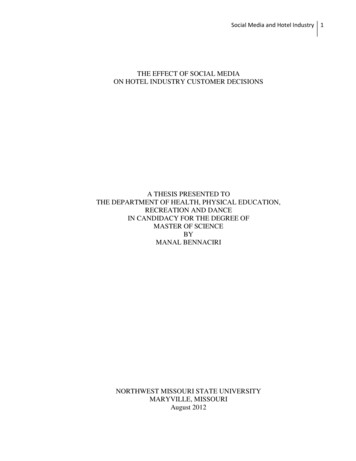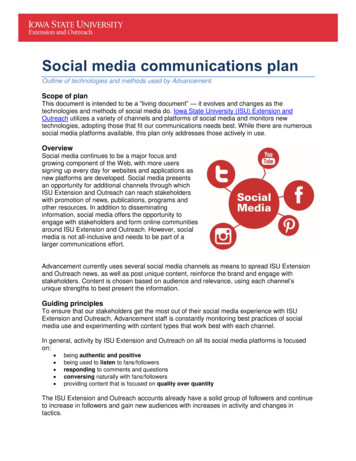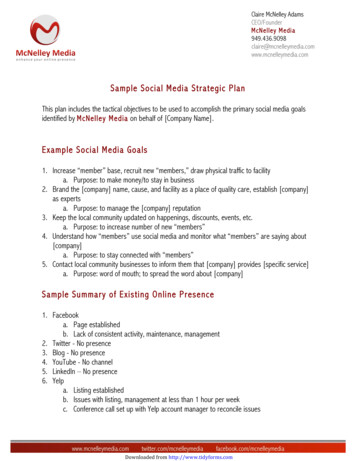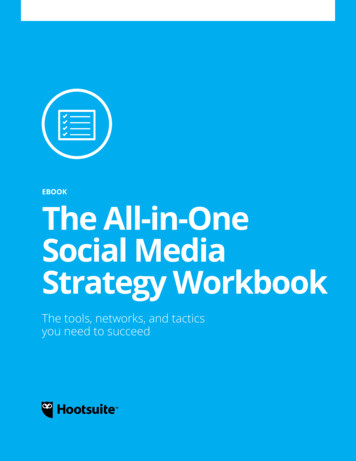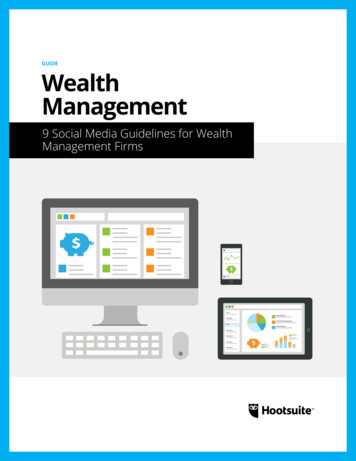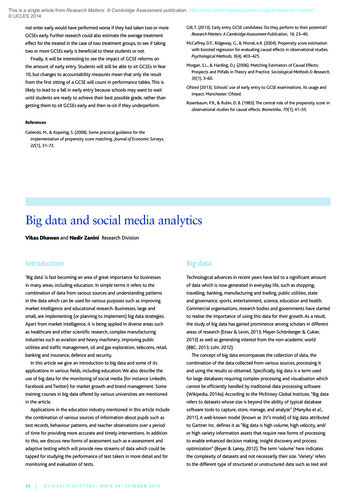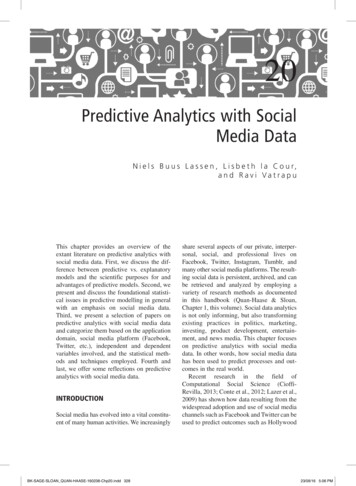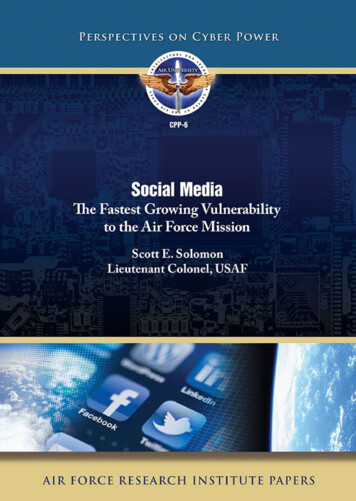
Transcription
Air UniversitySteven L. Kwast, Lieutenant General, Commander and PresidentAir Force Research InstituteDale L. Hayden, PhD, Director
AIR UNIVERSITYAir Force Research InstitutePerspectives on Cyber PowerSocial MediaThe Fastest Growing Vulnerabilityto the Air Force MissionScott E. SolomonLieutenant Colonel, USAFCPP–6Air University PressAir Force Research InstituteMaxwell Air Force Base, Alabama
Project EditorJames S. HowardCopy EditorCarolyn B. UnderwoodCover Art, Book Design, and IllustrationsDaniel ArmstrongComposition and Prepress ProductionVivian D. O’NealPrint Preparation and DistributionDiane ClarkAIR FORCE RESEARCH INSTITUTELibrary of Congress Cataloging-in-Publication DataNames: Solomon, Scott E., author. Air University (U.S.). Air Force ResearchInstitute, issuing body.Title: Social media, the fastest growing vulnerability to the Air Forcemission / Scott E. Solomon.Other titles: Air Force Research Institute perspectives on cyber power ;CPP-6. 2329-5821Description: Maxwell Air Force Base, Alabama : Air University Press, AirForce Research Institute, [2017] Series: Perspectives on cyber power,ISSN 2329-5821 ; CPP-6 Includes bibliographical references and index.Identifiers: LCCN 2016051206 ISBN 9781585662715Subjects: LCSH: Online social networks—Military aspects—United States. Online social networks—Security measures—United States. Internet—Safety measures. Social media—Government policy—UnitedStates. United States. Air Force—Airmen.Classification: LCC HM742 .S65 2017 DDC 302.30285—dc23 SUDOC D301.26/31:6LC record available at https://lccn.loc.gov/2016051206AIR UNIVERSITY PRESSDirector and PublisherDale L. Hayden, PhDPublished by Air University Press in January 2017Editor in ChiefOreste M. JohnsonManaging EditorDr. Ernest Allan RockwellDesign and Production ManagerCheryl KingAir University Press600 Chennault Circle, Building 1405Maxwell AFB, AL cebook.com/AirUnivPressandTwitter: https://twitter.com/aupressAir University PressDisclaimerOpinions, conclusions, and recommendations expressed or impliedwithin are solely those of the author and do not necessarily represent the views of the Air Force Research Institute, Air University,the United States Air Force, the Department of Defense, or anyother US government agency. Cleared for public release: distribution unlimited.Air Force Research Institute Perspectives on Cyber PowerWe live in a world where global efforts to provide access to cyberresources and the battles for control of cyberspace are intensifying. In this series, leading international experts explore key topicson cyber disputes and collaboration. Written by practitioners andrenowned scholars who are leaders in their fields, the publicationsprovide original and accessible overviews of subjects about cyberpower, conflict, and cooperation.As a venue for dialogue and study about cyber power and its relationship to national security, military operations, economicpolicy, and other strategic issues, this series aims to provideessential reading for senior military leaders, professional militaryeducation students, and interagency, academic, and private-sectorpartners. These intellectually rigorous studies draw on a range ofcontemporary examples and contextualize their subjects withinthe broader defense and diplomacy landscapes.These and other Air Force Research Institute studies are availablevia the AU Press website at http://aupress.au.af.mil/papers.asp.Please submit comments to afri.public@maxwell.af.mil.
ContentsList of IllustrationsvAbout the AuthorviiAbstractix1 The Problem 12 Threats and Vulnerabilities—What Is Differentfrom the Past? 3Mobile Device Vulnerabilities4Vulnerabilities of Free Apps 4Bring Your Own Device Program 53 Using Social Media—What is the Risk? 9Trends in Targeting Personal Information10Data Mining Personal Information 11Perceptions of Social Media Risk 114 Air Force Social Media Guidance—What’s Missing? 155 Recommendations 19Revise the Air Force Social Media Guidance19Best Practices for Cyberspace Operations 20Air Force Smart Cards 226 Conclusion 25Acronyms27Appendix29Bibliography35iii
List of IllustrationsFigure1Top industry BYOD concerns 62Top social media site trends 93The amount of time it can take to discover a compromise 104Maltego connection mapping 125Public perceptions of information security 136FBI Social Media Smart Cards 23Table1Air Force guidance evaluated162Gap analysis: Air Force Social Media Guidecontents compared with AFIs173Proposed framework of questions to revise the guidance 204Best practices 215Best practices 22v
About the AuthorLt Col Scott E. Solomon is assigned to the Air War College, Air University,Maxwell AFB, AL. Colonel Solomon is a career cyberspace operations officer.Born and raised in Southern California, he enlisted in the Air Force in 1988as a precision measurement equipment laboratory specialist. In 1993, he completed Officer Training School and became a communications and information systems engineering officer. His assignments include various cyberspace,space and airborne operational assignments, and various staff and engineering support positions in six major commands including the Air Staff. In 2006,he served as the joint forces air component commander’s command and control planner directly supporting Operation Iraqi Freedom and Operation Enduring Freedom. He has commanded a squadron and served as a deputygroup commander. In his prior assignment, Colonel Solomon was the executive officer to the vice commander, Air Education and Training Command.vii
AbstractSocial media is the fastest growing vulnerability to the military missionand the personal security of all Airmen. On 30 November 2014, the FBI issued warning to members of the US military and requested that they reviewtheir social media presence for any information like names and addresses thatmight attract the attention of violent ISIS extremists.1 Over the past decade,the convergence of mobile broadband devices has enabled social media tobecome more and more integrated into our everyday lives. The inherent risksand vulnerabilities of the internet and social networking sites like Facebook,LinkedIn, and Twitter along with the Air Force’s endorsement to actively usesocial media, has cultivated a rich and ripe environment for foreign adversaries and criminals to cherry-pick personal information about Airmen andtheir missions for nefarious activities. To help Americans understand therisks that come with being online, the Department of Homeland Securitylaunched a new cybersecurity awareness campaign: Stop, Think, and Connect.2 To educate Airmen on social media, AF public affairs created the “AirForce Social Media Guide” in 2013 to encourage Airmen to share their AFexperiences with family and friends in the social media environment. However, this is counter to the FBI’s guidance that promotes the reduction of users’ on-line footprint and online presence in cyberspace.3Notes(All notes appear in shortened form. For full details, see the appropriate entry in the bibliography.)1. Brown and Sciutto, “FBI warn military of ISIS threat.”2. DHS, “Stop, Think, Connect.”3. FBI, “Internet Social Networking Risks.”ix
Chapter 1The ProblemSocial media is the fastest growing vulnerability to the military missionand the personal security of all Airmen. In the networked world of desktopand mobile devices, the lines between official work and the personal use ofsocial media are getting harder to define. On 30 November 2014, the FederalBureau of Investigation (FBI) issued a warning to members of the US militaryand requested that they review their social media presence for any personalinformation like names and addresses that might attract the attention of violent Islamic State of Iraq and Syria (ISIS) extremists.1 Over the past decade,the convergence of mobile broadband devices has enabled social media tobecome more integrated into our everyday lives. Additionally, specific socialmedia sites such as Facebook, LinkedIn, and E-Harmony continue to shapeand influence the way we engage with others socially, for professional networking, and options for dating. The inherent risks and vulnerabilities of theinternet and social networking sites, taken with the Air Force’s endorsing theactive use of social media, has cultivated a rich and ripe environment for foreign adversaries and criminals to cherry-pick personal information aboutAirmen and their missions for nefarious activities.Public Affairs published the “Air Force Social Media Guide” in 2013 to encourage Airmen to share their Air Force experiences with family and friendsin the social media environment with the following introduction: “This guidewill help you share information effectively while following Air Force instructions and protecting operations security.”2 The guide does an excellent jobidentifying the “shoulds” and “should nots” in social media; however, theguide does not address hardware vulnerabilities or the risks of using socialmedia sites. This paper will respond to some of the most common threats andvulnerabilities of the social media environment, the risks of using social media, and the current Air Force social media guidance. It will also providerecom mendations to educate better and inform Airmen and their families onusing social media sites and cyberspace best practices.Notes(All notes appear in shortened form. For full details, see the appropriate entry in the bibliography.)1. Brown and Sciutto, “FBI Warn Military of ISIS Threat.”2. Air Force Public Affairs Agency. Air Force Social Media Guide, 2.1
Chapter 2Threats and Vulnerabilities—What IsDifferent from the Past?Today’s cyberspace environment provides an engaging interactive experience for social networking, picture and video sharing, and blogs that keep endusers engaged and wanting to share or consume more information. In addition to social media sites, commercial web services, online commerce services, and the hardware used for networking can provide the means to compromise sensitive information. Threats to desktop computer hardware areimportant but fall outside the scope of this paper; an example is in the notes.1Today’s hackers have discovered exquisite ways to install malware on a user’scomputer hardware through seemingly innocuous means by exploiting security breaches in social media websites that use Java, Ajax, or other popularsoftware technologies. Opening up files or hyperlinks attached to social media messages or email attachments may contain malware that can bypass firewalls or virus protection programs. In many cases, this happens without theuser knowing they have become a victim or that their hardware is infected.2Department of Defense (DOD) members are attractive targets for foreignadversaries and criminals using sophisticated scams and fraud schemes designed to take advantage of the unsuspecting users to extort information ormoney. One of the techniques used by malicious actors is to create fictitiousonline personas on popular social media sites and attempt to send “friend” or“connect” requests to potential targets.3 Unlike traditional spear-phishingemails with malicious attachments or hyperlinks that try to get unsuspectingvictims to execute the attachment, accepting a “friend” or “connect” requestadds a personal social touch to the process where the victim believes theyhave a personal connection with whoever sent the requests. This techniqueconditions the victim into thinking that whomever they connect to is a legitimate friend or a friend of a friend. As social media friends, these maliciousactors often attempt to make direct contact with the victim to solicit additional personal information for financial gain, identity theft, or informationto compromise the mission.Before the advent of smartphones and social media platforms, the predomi nant vulnerability for compromising privacy in cyberspace was hacking thehome computer. In 1988, the first computer worm referred to as the “MorrisWorm,” hit the internet and infected one out of every 20 computers.4 Sincethat time, bad actors have developed techniques that take advantage of built3
in hardware and software vulnerabilities to compromise personal data andsteal information. Additionally, as more people started using personal computers, hardware theft, careless password security practices, surfing infectedwebsites, and overall poor security practices made the job of stealing information easier for criminal actors. Over time, firewalls and virus protectionsoftware closed some of the vulnerabilities in home and business computers.Additionally, user education, automatic software updates, and better password management processes made stealing information harder for criminals.Fast forward to the present, the proliferation of mobile devices used for sharing personal information on social media networks has provided bad actorsnew opportunities to infect hardware with malware that can take over computer functions or divulge personal information.Mobile Device VulnerabilitiesAccessing social media is today’s number one mobile activity. Of those surveyed, 71 percent use their mobile phone to access social media.5 Today’s mobile devices are extremely capable minicomputers that can give users much ofthe same functionality as their home computer while providing portable capabilities that can enhance or provide productivity while on the go. Due to theproliferation of mobile devices, many folks spend more time processing information on their mobile devices than they do at home. In fact, internet usage on mobile devices exceeded personal computer usage for the first time inearly 2014.6 Functionality and productivity achieved with the use of embedded or downloadable apps have created another vulnerability that marketingfirms and malicious actors can use to track an individual’s location, consumepersonal information, or add malware to a device for future exploitation. Inthe last example, once access is established with malware, it can be hard todetect and clean before any information is compromised.Vulnerabilities of Free AppsSymantec’s latest “2013 Internet Security Threat Report” stated that information stealing is the top threat from mobile malware or overly aggressive adnetworks.7 Free apps and embedded social media programs that come preloaded on mobile devices may be appealing to use, but they may be placingpersonal information at risk. Some of the free apps out there may not cost realmoney but can cost in terms of time spent getting past nuisance ads, limited4
program functionality, or exposing personal information to third party vendors. The most common examples are as follows: The developer gets paid for providing banner advertising for otherproducts.The developer limits the functionality or features of the app.In these cases, a small fee is required to remove the advertising or to activatea full functioning product. The other common practice for a free app is togrant the program elevated permissions to view personal information, discover accounts, read contacts, and even read text messages. Before installinga free app, it is important to note that the app may have elevated permissionsthat can enable information collection activities.One of the keys to protecting one’s information is to understand what permissions the app may need to do its job before installing it. As more and morefamilies use mobile devices with social media apps to stay in touch with deployed family members and friends, they may be unknowingly putting personal information at risk. In 2003, three Estonian programmers located inSweden created the popular video chat software application called “Skype.”8 Itwas an instant hit in the United States and abroad which brought video chatcapability to the home computer. With the advent of smartphones, this creat edan opportunity to provide a free mobile app in return for some elevated permissions. The latest Skype app acquires permissions to read text messages,storage contents, and an extensive list of other items that provide personalinformation. Skype’s privacy policy states that they can collect, analyze, andprovide third-party service providers with personal data, messages, and passwords under the guise of “providing you with a safe, smooth, efficient, andcustomized experience.” Before installing an app, evaluate the risk by readingthe developer’s privacy policy and permission details.Bring Your Own Device ProgramTo add another vulnerability to the mix, the White House Federal chiefinformation officer put out the “Digital Government Strategy” in 2012 on itsnew Bring Your Own Device (BYOD) program for government agencies soyou can use your personal device for official work. This new strategy openedthe door for government agencies to explore the reality of allowing employeesto use personal computer or mobile devices for official work. The US EqualEmployment Opportunity Commission ran one of the first pilot programsusing personal mobile devices for official work. The pilot showed favorable5
user results and reduced overall operational costs for the organization.9 Manygovernment agencies are moving forward to take advantage of the BYODprogram.The Air Force is also working towards a mobile device rollout plan that willallow its members to use government email and applications on their personal devices for official work. To ensure mobile device data security requirements are operationalized, the Air Force teamed up with “Good Technology”to provide a software solution that keeps official data separate and secure byusing a secure software container approach to store information on the device.10 This software add-on enables the use of official email and other workapplications on a personal device while retaining the ability to access personal applications. While protecting data through security is a top concernfor most organizations, there are many more factors to consider for a successful BYOD program rollout as shown in figure 1 below.11 Regardless ofhow well the Air Force deploys BYOD to Airmen, software add-ons will notbe a panacea for mitigating the vulnerabilities or risk of storing official dataon personal devices.Figure 1. Top industry BYOD concerns (Reprinted from Forrester Consulting,“Key Strategies to Capture and Measure the Consumerization of IT.”)6
When evaluating the risk and vulnerabilities of storing official informationon personal devices, the current statistical research infers that the risk of exposing “For Official Use Only” or privacy act information will increase. PewResearch Center studies show approximately 22 percent of the total numberof mobile devices will be lost or stolen during their lifetime with only 50 percent recovered intact. A growing number of these stolen devices purposelyhave their content accessed by someone other than the owners.12 Accordingly,as more and more people use the BYOD program for work, the risk of exposing official information will climb due to the physical loss or theft of devices.Therefore, while the BYOD program may reduce the overall operating costfor the government and provide convenience to the end user, encrypting data,user education, and strong mobile security are key to protecting the information. As new vulnerabilities are regularly discovered, user education and theprocess of securing information networks and systems must be continuousand timely.Notes1. Authors Note: On 15 August 2012, a malicious virus allegedly developed by Iran attacked the Saudi oil company Aramco that resulted in erased documents, spreadsheets, emails,and files on over 30,000 corporate PCs. The attack shut down major operations and took 11days to restore the computers back to normal operations. In some cases, malware has sat idleand undetected for years until the vi
May 11, 2017 · in hardware and software vulnerabilities to compromise personal data and steal information. Additionally, as more people started using personal com-puters, hardware theft, careless password security practices, surfing infected websites, and overall poor securi



